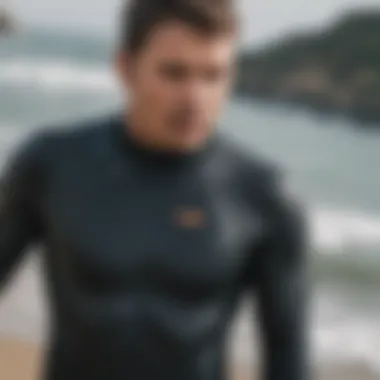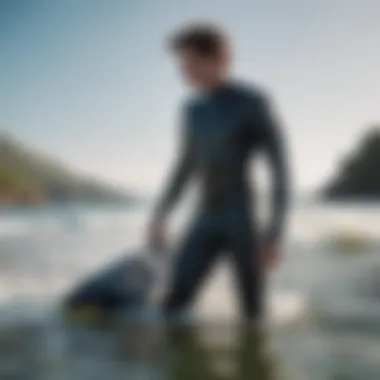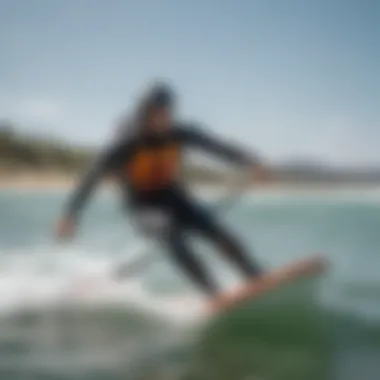The Ultimate Guide to Durable Wetsuits for Kiteboarding


Intro
Kiteboarding demands not only skill but also the right gear to optimize performance on the water. Among the essential pieces of equipment, a wetsuit plays a pivotal role, ensuring warmth and flexibility during activities. But, durability is perhaps the biggest concern for enthusiasts who want their gear to withstand rough conditions. With various brands and materials flooding the market, making an informed choice can feel overwhelming.
The quest for a durable wetsuit goes beyond a mere financial investment. It's about ensuring one’s comfort and enhancing their kiteboarding experience. This exploration helps peel back the layers on what to truly look for in a wetsuit, from materials to user experiences, giving kiteboarders the tools to make an educated decision. Ultimately, selecting the right wetsuit contributes to a rewarding adventure, whether you're catching waves or simply enjoying the wind in your face.
Understanding Wetsuits and Their Purpose
Wetsuits serve as a critical component in the gear of kiteboarding enthusiasts, designed not just to keep a wearer warm but to enhance overall performance while engaging in this exhilarating sport. Understanding the purpose of wetsuits can significantly inform your choice when it comes to durability, which is paramount for a successful kiteboarding experience. This section will delve into defining what a wetsuit is, its performance-enhancement capabilities, and the significance of durability directly related to water and weather conditions.
What is a Wetsuit?
A wetsuit is a snug-fitting garment made primarily from neoprene, and its main goal, often considered its most necessary function, is to provide insulation in cold water. The rubber-like material traps a thin layer of water between the suit and the skin, which heats up from your body temperature, keeping you warmer than if you were simply immersed in cold water. Wetsuits can come in various styles, ranging from full suits that cover the arms and legs to shorty versions that leave arms and legs exposed for warmer conditions. This versatile piece of gear is a staple for anyone venturing into kiteboarding, offering a practical way to combat the elements.
How Wetsuits Enhance Performance
The role of a wetsuit in enhancing performance cannot be overstated. They not only keep you warm but also offer buoyancy, helping you stay afloat without expending excessive energy. A properly fitted suit allows for a greater range of movement, which is critical when navigating demanding wind and water conditions. Having a suit that fits like a glove minimizes drag, letting you slice through the water seamlessly. Whether you're jumping high or riding the waves, the added buoyancy and reduced fatigue can make a real difference in performance.
“Choosing the right wetsuit is about more than just staying warm; it’s about maintaining the edge that turns an average ride into an unforgettable one.”
The Importance of Durability
When it comes to durability, a wetsuit is an investment that pays dividends every time you hit the water. The constant exposure to salt, chlorine, and UV rays can take their toll on fabric, making durability an essential consideration. A robust wetsuit can withstand the rigors of kiteboarding, which includes frequent falls, abrasions from sharp surfaces, and prolonged exposure to the elements.
Moreover, a durable wetsuit doesn’t just protect you physically; it offers peace of mind, allowing you to focus on your ride rather than worrying about your gear. Your choice of wetsuit can directly affect how long it lasts, making material quality and construction methods vital factors to weigh. Understanding these aspects provides insight into how to select a wetsuit that will serve you well over time, ensuring that every adventure on the water is as enjoyable as the last.
Materials Used in Wetsuit Construction
Understanding the materials used in wetsuit construction is absolutely crucial for kiteboarding enthusiasts. The right material not only impacts comfort and flexibility but also plays a significant role in durability. Different materials bring various benefits and considerations to the table which can dramatically affect performance in the water. For someone serious about kiteboarding, the choice of materials can mean the difference between slicing smoothly through waves or struggling against the elements.
Neoprene: The Industry Standard
Neoprene is the turf king in the wetsuit universe. This synthetic rubber material has a knack for delivering unparalleled insulation and flexibility, making it the go-to for most manufacturers. Neoprene traps a thin layer of water between the suit and the body, which warms up quickly from body heat, providing thermal protection essential for longer sessions in cooler waters. With its versatility, neoprene comes in various thicknesses, allowing riders to choose their level of warmth based on the conditions.
However, not all neoprene is created equal. There are variations such as limestone neoprene, which is a more eco-friendly option compared to traditional petroleum-based neoprene. This kind often boasts higher durability and buoyancy. Crucially, when selecting a wetsuit, you want to consider the quality of neoprene, as this directly affects the longevity of the suit.
Alternative Materials: A Comparative Overview
While neoprene holds the crown, other materials are starting to make waves in the wetsuit scene. Fabrics like Yamamoto neoprene, derived from Japanese sources, promote better stretch and lightness. They also tend to resist water absorption, enhancing insulation properties.
Some notable alternatives include:
- Ecolast: A more sustainable option, made from recycled materials, catering to the eco-conscious rider.
- Merino Wool: Surprisingly, some suit designs feature merino wool for added insulation and comfort.
- Terry Cloth Linings: Not exactly a material on its own, but linings like these often provide comfort and warmth, making the wetsuit easier to put on and take off.
Each of these materials offers unique attributes that may suit different conditions or personal preferences. Ultimately, high-performance suits may even blend materials to optimize function, enhancing both comfort and durability for riders.
Evaluating Material Quality
When diving into the world of wetsuit materials, assessing quality is key to making the right investment. Here are some factors to keep in mind when evaluating material quality:
- Thickness: A thicker wetsuit tends to offer more insulation, but it can also be bulkier, impacting flexibility. A balance between thickness and flexibility stipulates performance in unpredictable conditions.
- Stretchability: High-quality materials should stretch adequately to allow for a full range of motion. If you feel constricted in a wetsuit, it can hinder your performance in the water.
- Finishing Treatments: Some materials undergo treatments like water repellence or UV protection. These can contribute to the wetsuit's lifespan, ensuring it doesn’t degrade easily under harsh conditions.


High-quality materials coupled with proper maintenance lead to longevity and enhance overall performance.
Key Features Affecting Wetsuit Durability
When diving into the conversation around durable wetsuits, it’s essential to focus on specific features that significantly impact their lifespan and effectiveness. Just like a craftsman selects only the finest tools for precision work, kiteboarders must consider these key aspects when choosing a wetsuit. Each feature, from thickness to the quality of seams and zippers, plays a pivotal role in how well the suit holds up against the challenges of kiteboarding, ensuring that enthusiasts can ride the waves without a hitch.
Thickness and Insulation
Thickness is often seen as a straightforward feature, yet it can make a world of difference under certain conditions. In cooler waters, a thicker wetsuit serves not just to shelter the wearer from the cold but also adds a layer of buoyancy and comfort. Most commonly, wetsuits range from 2mm for warmer environments to 5mm or more for frigid waters.
"Choosing the right thickness is like finding the Goldilocks zone – not too much, not too little, just right for comfort and performance."
However, one must tread carefully here; thicker suits bring along challenges such as reduced mobility. An overly thick wetsuit can restrict movement or make paddling out cumbersome. Therefore, understanding the water temperature and personal comfort is crucial. Insulation materials, too, vary. Some suits feature advanced thermal linings which help retain body heat without bulk. Ensuring that the suit’s thickness aligns with your riding style and intended environment can prolong its usability.
Seam Types and Their Impact
Another important factor is the type of seams used in wetsuit construction. Not all seams are created equal. Overlocked seams might be comfortably flexible but can allow water to seep in, potentially leading to troublesome chill during rides. On the flip side, blind-stitched seams create a watertight barrier, offering not just insulation but also improved durability against wear and tear.
When selecting a wetsuit, consider:
- Overlocked seams: Great for flexibility but can introduce water leakage.
- Blind-stitched seams: Provide superior waterproofing and tend to last longer under stress.
- Taped seams: Extra reinforcement can enhance strength, yet they may come at a higher price.
Ultimately, the stitching method can determine how long the wetsuit lasts, especially after multiple uses in harsh environments. Good seam construction is like the foundation of a sturdy building; it ensures stability and longevity.
Zipper Quality and Placement
The zipper might seem like a mere detail, yet it’s crucial for both functionality and durability. A low-quality zipper can be a headache, leading to failures at inopportune moments. Consider the placement too: back zippers work well for flexibility but can strain certain areas, while front zippers offer greater comfort during wear. One must also pay attention to the type of zipper—heavy-duty plastic or metal zippers can vastly impact longevity.
When choosing a suit, you'll want to check for:
- Zipper type: Metal is sturdy, but plastic zippers might offer weight benefits.
- Placement: Front zippers allow for more room to move, avoiding stress on the lower back.
- Waterproof features: A zipper with a flap or cover adds another layer of protection against the elements.
Selecting the right zipper takes time and thought, but when done right, it can go a long way in making the suit reliable and prolonging its life on the waves.
Comparative Analysis of Leading Wetsuit Brands
Choosing the right wetsuit is a crucial aspect for kiteboarders aiming for an exceptional experience on the water. Engaging in a comparative analysis of leading wetsuit brands helps identify which manufacturers offer the best durability, comfort, and performance features. This section delves into the significance of brand reputation, user feedback, and how different brands stack up against each other. By breaking down these elements, we guide readers towards informed decisions that align with their specific needs and preferences.
Brand Reputation and User Feedback
Brand reputation plays a pivotal role in any purchasing decision, but this is particularly true for wetsuits. Kiteboarders often rely on the insights and reviews from other enthusiasts who have already tested the products. These testimonials provide unfiltered experiences which can be more enlightening than advertisements or product descriptions.
Key aspects of brand reputation include:
- Longevity: How long a brand has been in the market can indicate its reliability.
- Community Trust: A brand favored by professional kiteboarders often suggests quality and performance.
- Quality Control: User reviews can spotlight any recurring issues, letting potential buyers know if a brand truly lives up to its promises.
Connecting with fellow kiteboarders and visiting forums on platforms like Reddit can provide depth to the understanding of various brands based on personal experiences. It’s not uncommon for specific user feedback to sway a decision one way or the other.
Top Brands and Their Line-ups
Here, we take a closer look at notable brands that have made a mark in the wetsuit industry, particularly for kiteboarding. Each brand has unique qualities and offerings that cater to various preferences and needs.
Brand A


Brand A stands out due to its commitment to using eco-friendly materials without sacrificing performance. The incorporation of recycled materials into its wetsuits attracts environmentally-conscious consumers.
- Key Characteristic: Remarkable thermal insulation that maintains warmth during extended sessions in cooler waters.
- Unique Feature: The seamless design minimizes water entry and maximizes comfort, making it a popular choice among kiteboarders.
However, while the eco-friendly approach is commendable, some users may find the price point slightly elevated compared to other brands with similar durability ratings.
Brand B
Brand B boasts a lineage steeped in water sports and has a loyal user base that swears by its products. Known for creating highly customizable wetsuits, this brand allows kiteboarders to tailor their gear to fit specific needs.
- Key Characteristic: Excellent flexibility due to the type of neoprene used, which is essential for high-mobility sports like kiteboarding.
- Unique Feature: The "MyWetsuit" option, where customers can personalize colors, thickness, and zipper placements to optimize their wetsuit experience.
Nevertheless, the extensive customization can lead to longer waiting times for product delivery, a factor some prospective buyers might consider.
Brand
Brand C is recognized for its durability and robust construction. Designed primarily for extreme conditions, these wetsuits have been put through the wringer by professional kiteboarders without showing significant wear.
- Key Characteristic: Sturdy seams that resist stress from various water activities, offering longer lifespans compared to alternatives.
- Unique Feature: The double-lined neoprene which not only improves insulation but adds an extra barrier against abrasions and inevitable encounters with gear or the ocean floor.
One drawback could be its weight; some users find Brand C's suits a bit heavier, which they feel affects buoyancy at times.
Cost vs. Durability: Finding Balance
When investing in a wetsuit, balancing cost and durability is paramount. A premium wetsuit may promise exceptional longevity and performance, but the average kiteboarder must consider their budget alongside the conditions they usually face.
Cost-effective options that are durable are often available, but cutting corners too much may lead to dissatisfied performances when it counts. Thus, consumers ought to assess possible trade-offs based on their particular usage, preferences, and the environments they frequently kiteboard in.
Choosing the Right Wetsuit for Kiteboarding
Selecting the right wetsuit is like finding the perfect toolkit for a craftsman; it’s not just about covering yourself but equipping your adventure. In kiteboarding, the conditions can swing wildly, and having the ideal wetsuit ensures not only protection but also peak performance on the water. Whether you're a seasoned pro or just dipping your toes, understanding the nuances that come into play when choosing a wetsuit allows for a more enjoyable ride.
Your wetsuit must match your specific demands and the environmental conditions you’re likely to face. Factors such as water temperature, wind speed, and duration of your sessions all play a crucial role. Getting this element right can make the difference between a revelatory experience and one that leaves you shivering and uncomfortable.
Assessing Your Needs and Conditions
Before you take the plunge into selecting a wetsuit, consider the conditions you will be facing. Are you kiteboarding in the chilly waves of the Pacific or the warm, inviting waters of the Caribbean? The water temperature dictates the type and thickness of the wetsuit you should be looking at.
- Temperature Range:
- Cold Water (below 65°F / 18°C): You’ll need a thick wetsuit, possibly in the 4/3 or 5/4 mm range, to keep your body heat intact.
- Temperate Water (65-75°F / 18-24°C): A 3/2 mm suit may suffice, offering insulation without being overly bulky.
- Warm Water (above 75°F / 24°C): In these conditions, you might want a shorty or even a long-sleeve top, around 1-2 mm in thickness, or even no wetsuit at all.
Another vital point to assess is how often you kiteboard. If you’re a frequent flier on the water, investing in a high-quality suit that withstands regular use is essential.
Fit and Comfort Considerations
How well your wetsuit fits can impact your entire kiteboarding experience. A suitable wetsuit keeps you snug without restricting your movement. Consider these fit factors when choosing:
- Size: The suit should be tight, but not uncomfortably so. Check the manufacturer’s sizing chart, and consider trying it on if possible.
- Flexibility: Look out for suits with flexible panels or special materials that allow for ease of movement, especially around your shoulders.
- Seam Construction: Blind-stitched seams give you better flexibility and a more streamlined fit, reducing water entry and enhancing comfort.
Comfort directly affects performance; if you’re tugging at a loose suit or struggling with restricted movement, you can bet that your agility on the board will suffer.
Maintenance Tips for Longevity


Owning a durable wetsuit is only part of the equation; looking after it is just as crucial. Proper maintenance can keep your suit in fighting shape for years. Here are some simple, yet effective care tips:
- Rinse After Use: Always rinse your wetsuit with fresh water after a session. Saltwater and sand can degrade the fabric over time.
- Dry Correctly: Turn the wetsuit inside out when drying and avoid direct sunlight, which can damage the neoprene. Hang it away from anything sharp that could puncture or tear it.
- Storage: When storing your wetsuit, lay it flat or hang it on a wide hanger to avoid creasing.
- Avoid Stretching: Never pull on the suit excessively when getting in and out, and steer clear of rough surfaces that may stretch or tear when you're putting it on.
Taking these actions can extend the life of your wetsuit, ensuring you're well-prepared for every kiteboarding session.
"A wetsuit that feels good, suits your needs, and lasts through the seasons is a kiteboarder's best friend."
By thoughtfully assessing your kiteboarding situations, focusing on fit, and practicing good maintenance habits, your journey to find the right wetsuit becomes not just a checklist but a pathway to exploring the waters with confidence.
Case Studies of Wetsuit Durability
When it comes to evaluating wetsuit durability, case studies serve as a powerful inductive tool. They offer real-world insights that mere technical specifications can often gloss over. User experiences and professional feedback can reveal certain patterns or pitfalls in the performance of various wetsuit brands and models, as well as provide a framework for understanding why some wetsuits stand up to the rigors of kiteboarding better than others. This examination helps to demystify durability issues, suggesting lessons learned and strategies that future wearers might employ to inform their purchase decisions and subsequent usage.
User Experiences: Longevity Records
User experiences provide a treasure trove of information regarding the longevity of wetsuits. Many kiteboarders, after a few seasons of riding waves and cutting through currents, have taken the time to share their findings. For instance, one kiteboarder recounts how his second-hand Excel wetsuit lasted nearly five seasons. He noted that regular maintenance, like rinsing it out with fresh water after each session, seemed to keep it in surprisingly good condition. Others have countered this with cautionary tales—wetsuits that ripped or deteriorated within a single summer due to improper care or manufacturing flaws.
Users often highlight what they call the "comfort factor" as an important part of durability. For instance, if a wetsuit is uncomfortable, it might lead to less careful handling and more accidental damage. A snug fit can also influence durability; too tight can cause wear on seams, while too loose risks catching on gear or inflatables. Therefore, users suggest that a perfect fit and comfort can significantly affect how long a wetsuit holds up in the field.
Professional Insights from Kiteboarders
Professional kiteboarders, who often rely on high-performing gear, offer a nuanced perspective on wetsuit durability. Their insights often reflect on how performance can be interlinked with the longevity of a wetsuit. One noted professional shared that they only trust suits from specific brands, citing their extensive testing and quality control processes. This highlights a crucial takeaway: not all wetsuits are created equal. They emphasized looking into each brand's reputation and manufacturing methods.
Moreover, professionals often discuss the toll that different conditions can take on wetsuits. Saltwater can degrade materials over time, while persistent UV exposure can make fabrics brittle and prone to tearing. Through their experiences, it's clear that environmental factors play a significant role in durability. They recommend specialized suits for various conditions. A thicker variable suit may excel in colder waters while a lighter, streamlined design works better in warmer settings, emphasizing adaptability in durability.
Analysis of Wetsuit Failures
Analyzing wetsuit failures offers a sobering yet informative perspective. Many users experience wear and tear that could have been anticipated through more thorough scrutiny of seams, zippers, and material quality. For instance, some users noted that wetsuits with flatlock seams lasted longer than those with overlocked seams, especially during extreme activities. Conversely, zippers often serve as the Achilles' heel of many wetsuits. A torn zipper may render a suit unusable, yet many brands skimp on this vital part, focusing instead on the body.
An accumulation of user feedback indicates that many issues arise from improper sizing. A wetsuit that's too small can lead to unnecessary stress, while a suit that's too large may cause garment failures from snagging. A particular telltale indicator of failure can be the way certain brands design their seams and zippers. Users reported far greater durability with brands that prioritized waterproof zippers and reinforced seams. In summary, this analysis paints a vivid picture of how even small design details can lead to major impacts on the overall life of a wetsuit.
Understanding real-world durability related to wetsuits is essential. The stories and testimonials from actual users and pros can guide potential buyers, focusing on what they value the most. Find their shared wisdom to make better choices.
Epilogue and Future Considerations
As we reach the end of our detailed exploration into the world of wetsuits, particularly for the kiteboarding enthusiast, it's essential to revisit some of the pivotal themes discussed. The selection of a wetsuit is not merely a matter of personal preference or trend; it’s a critical decision that directly affects your experience on the water. The right wetsuit combines comfort, flexibility, and most crucially, durability, ensuring that it withstands the rigors of kiteboarding while keeping you warm and protected.
Summary of Findings
Through our analysis, we uncovered that there are several crucial factors influencing wetsuit durability:
- Material Quality: Neoprene remains the primary choice for most wetsuits; however, alternative materials are paving new paths in terms of sustainability and flexibility. Higher-density neoprene generally enhances durability but may compromise flexibility if too thick.
- Construction Techniques: The seams and zippers are vital. Double stitched and glued seams offer greater longevity compared to flatlock seams. Quality zippers, especially those that are corrosion-resistant, enhance the lasting power of a wetsuit.
- User Reviews and Brand Reputation: Engaging with fellow kiteboarders and reviewing feedback on various brands gives insight into what to expect in terms of durability and performance.
"A wetsuit is only as good as its weakest link. Pay attention to every detail, from the zipper to the seams."
— Anonymous Kiteboarding Pro
Innovations in Wetsuit Design
Looking ahead, wetsuit technology is evolving at an impressive pace. New innovations aim to balance durability with environmental responsibility. For instance, brands are developing wetsuits using recycled materials, reducing waste while delivering high performance. Additionally, advancements such as thermal lining technology improve insulation without adding bulk, enhancing comfort during long hours on the water. Some companies are also experimenting with materials that incorporate graphene, a wonder material known for its strength and lightweight properties, promising even more durable and flexible suits in the future.
- Increased focus on sustainability offers kiteboarders a chance to make more environmentally conscious choices without sacrificing performance.
- Newly developed changing technologies, like water-repellent coatings, can greatly reduce the time you spend drying after a session, providing more comfort.
Final Recommendations
When it comes down to choosing a wetsuit that stands the test of time, consider these recommendations:
- Invest in Quality: Always opt for brands that have a proven track record in durability. While it might pinch your wallet initially, a durable wetsuit will pay off in the long run.
- Make Fit a Priority: A well-fitted wetsuit not only offers comfort but also performs better, benefiting from less water entry and improved insulation.
- Routine Maintenance: Regular washing with fresh water and hang drying away from direct sunlight can greatly extend a wetsuit's life.
- Stay Informed on Innovations: Follow trends and advancements in wetsuit technology to ensure you're using the best possible gear for your kiteboarding adventures.
In summary, the quest for the most durable wetsuit isn't a one-and-done journey but rather an ongoing process that requires attention to detail, an understanding of materials and design, and a proactive approach to maintenance. By integrating these insights, kiteboarders can embark on their adventures equipped with confidence and style.















